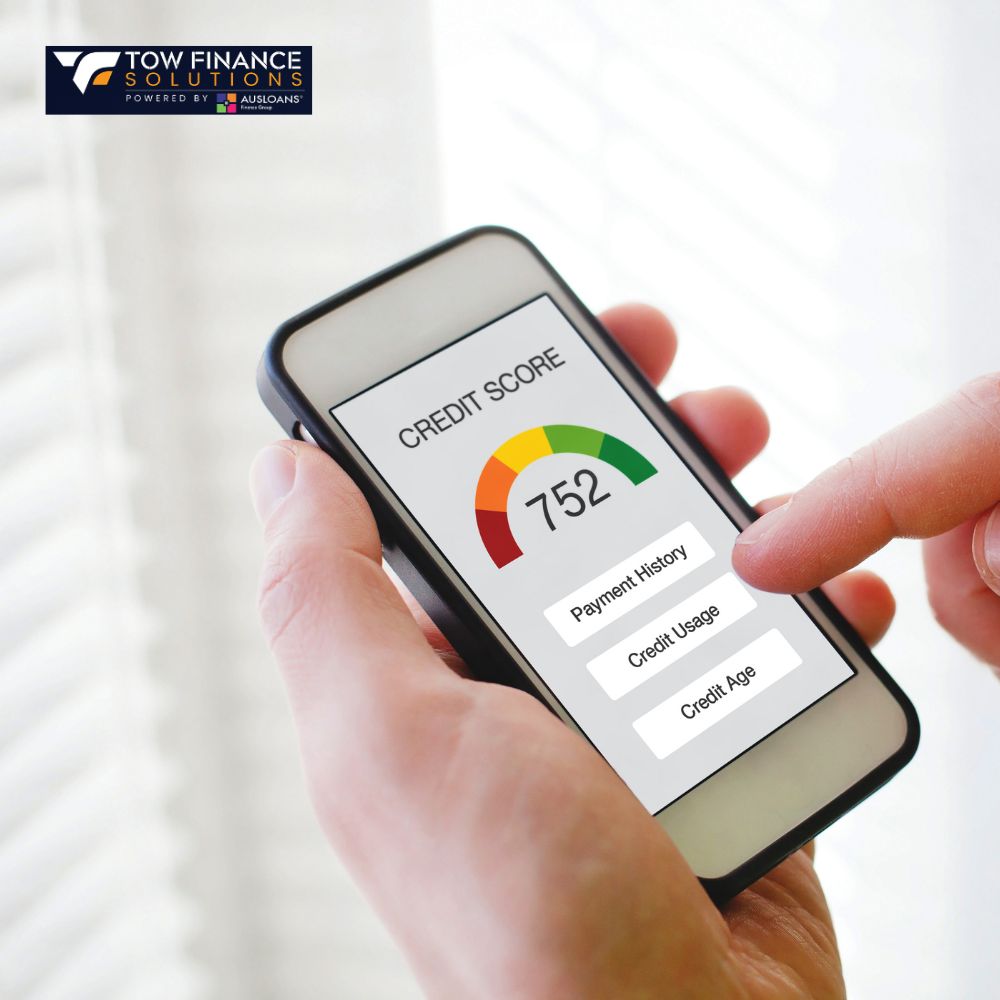How To Fix a Low Credit Score in 5 Steps
April 1, 2025
Are you struggling with a low credit score in Australia? This guide will show you how to fix it in five easy steps. At Tow Finance Solutions, we’ve created this resource to help you improve your credit score. It covers strategies for dealing with defaults, errors, and high debt, all tailored for Australians.
Our guide makes credit repair simple by breaking it down into clear steps. You’ll learn how to get your free credit report, pay off overdue debts, and improve your score. We promise no jargon, just practical tips to help you regain financial confidence.
Find The Best Deal

With over 10 years of industry experience we are a leading independent broker with a diverse panel of 40 + lenders to find you the best solution, tailored to you and your goals!
Key Takeaways
- Follow five proven steps to improve your credit score and access better financial opportunities.
- Obtain free credit reports to spot errors that could be dragging down your score.
- Address overdue debts and establish consistent payments to rebuild trust with lenders.
- Lower credit utilisation and monitor progress using strategies from Tow Finance Solutions.
- Learn to avoid common myths that might slow your recovery.
Understanding Credit Scores in Australia
At Tow Finance Solutions, we understand that boosting your credit score begins with knowing how it works. In Australia, your credit score affects your loan access and interest rates. By grasping what influences your score, you can tackle how to fix low credit score more effectively.
What Makes Up Your Credit Score
Lenders consider five key factors:
- Payment history (late payments harm your score)
- Credit utilisation (how much of your credit limit you use)
- Credit history length (longer histories can improve scores)
- Credit types (mix of loans/building diverse credit)
- Recent applications (too many inquiries in a short time lower scores)

Why Your Credit Score Matters in the Australian Financial System
Your credit score is very important in Australia. It helps lenders, landlords, and service providers decide if they can trust you. A good score means you can get better deals on loans and credit cards.
- Loan approvals: Banks and financial institutions prioritize applicants with higher scores.
- Rental Agreements: Many landlords check scores to assess tenant stability.
- Insurance premiums: Insurers may offer discounts to those with good credit histories.
- Employment: Some industries, like finance, review credit reports during hiring.
“A credit score is more than a number—it’s a tool that shapes your financial future,” says the Australian Securities and Investments Commission (ASIC). “Improving it can open doors to better financial opportunities.”
A low score can make it hard to get good loan terms or even find a place to live. For example, a bad score might mean you pay more interest on a home loan. But, a good score can lead to pre-approved offers and easier repayment plans.
Understanding how your score affects you is the first step to improving your finances. We will show you how to fix low credit score issues. Every step you take gets you closer to better deals, lower costs, and more financial freedom.
Step One: Obtain Your Current Credit Report
Before you can improve your credit score, you need to know where you are. how to fix low credit score begins with checking your credit history. You may contact us to get a credit report.
At Tow Finance Solutions, we advise checking these reports to ensure accuracy across agencies.
Understanding What You’re Looking At
Each report has:
- Personal details (name, DOB, addresses)
- Credit accounts (loans, credit cards)
- Repayment history (30/60/90-day delinquencies)
- Defaults, court judgments, or bankruptcies
- Credit enquiries from lenders
Identifying Errors on Your Credit Report
Look for:
- Mistyped names or addresses
- Accounts you never opened
- Incorrectly listed defaults
- Outdated negative information
Report errors to the credit bureau and the creditor using their dispute forms. Corrections can boost your score quickly.
Step Two: Address Outstanding Debts and Defaults
To fix a low credit score, start by tackling outstanding debts. First, list all overdue accounts and defaults on your report. Then, sort these debts by age and impact. Newer debts hurt your score more than older ones.
- Contact creditors directly to discuss payment plans or reduced settlements.
- Ask for a goodwill adjustment for occasional late payments caused by temporary hardships.
- Document all conversations, agreements, and settlement terms in writing.
“Debt collectors must treat you respectfully under Australian Consumer Law. They cannot threaten or harass you, even if you owe money.”
Settlements or full payments won’t instantly remove past defaults. But, they stop further damage. After paying off debts, make sure creditors update your accounts. Negative entries can stay on your report for 5–7 years. But, showing you’re actively repaying helps improve your score.
If debts are too much, Tow Finance Solutions can help. They offer repayment plans to help you rebuild your credit. Taking consistent action on overdue accounts is key to boosting your score over time.
Step Three: Establish Positive Payment Patterns
Building a strong credit history starts with making consistent, on-time payments. Payment history is the biggest factor in your credit score. So, it’s key to develop good habits for those looking to improve their score.
Small actions today can lead to big changes over time. It’s all about starting with the right steps.
Setting Up Automatic Payments
Automating payments helps avoid late fees and missed deadlines. Here’s how to do it:
- Link accounts for automatic bill pay through your bank.
- Prioritize high-interest debts first to reduce financial strain.
- Check account balances weekly to avoid overdrafts.
Creating a Debt Management Plan
Keep track of your spending and payments with a clear plan. Begin by:
- Listing all debts with balances and interest rates.
- Allocating extra funds to highest-interest debts first.
- Using budgeting apps to stay on track.
Does Zip Money Affect Credit Score in Australia?
Buy-now-pay-later services like Zip Money now report to credit bureaus. Missing payments can hurt your score. Always pay on time to protect your credit score.
Does Step Pay Affect Credit Score?
Step Pay’s effect on your score depends on their reporting. Check the terms carefully—late payments might show up on reports. Always confirm with providers if unsure about their credit reporting policies.
Step Four: Maintain Low Credit Utilisation Ratios
Managing your credit utilisation ratio is key to how to fix low credit score issues. This ratio shows how much debt you have compared to your total credit limit. Keeping it low shows lenders you handle credit well.
What Is Credit Utilisation?
Credit utilisation is how much of your available credit you’re using. For instance, if you owe $1,000 on a $5,000 limit, your ratio is 20%. High ratios can signal lenders that you might rely too much on credit.
Ideal Credit Utilisation Percentages
| Ratio | Impact on Credit Score |
| Below 10% | Best for top credit scores |
| 10–30% | Good, but aim lower for optimal results |
| Above 30% | Reduces score; over 75% harms credit significantly |
Strategies to Lower Your Credit Utilisation
- Paying down balances faster than monthly minimums
- Requesting credit limit increases (call providers directly)
- Leaving older accounts open to boost total available credit
- Making mid-month payments to lower reported balances
Tow Finance Solutions suggests checking your credit utilisation ratio every month. Small changes can boost your score quicker than other steps. Don’t close old accounts or apply for new credit unless it’s really needed.
Step Five: Monitor and Protect Your Improving Credit
Keeping an eye on your credit score is essential for a healthy financial life. how to fix low credit score plans are more effective with regular monitor credit score australia checks. Here’s how to stay on top of it:
- Free annual credit reports from Experian, Equifax, and Illion
- Paid subscription services for real-time updates (e.g., Credit Simple, Finder’s credit score tracker)
- Bank apps like Commonwealth Bank’s “Credit Score” feature
Look out for these signs of improvement or trouble:
| Sign | Meaning |
| Rising score | Positive habits are working |
| Sudden drops | Potential errors or fraud |
| New inquiries | Unrecognised applications |
Here’s how to safeguard your credit score:
- Set fraud alerts via the ICNA
- Review bank statements weekly for odd transactions
- Use two-factor authentication on all financial accounts
- Freeze credit access if moving or traveling
Consistency is key. Even small actions, like checking your score monthly, can keep your credit in good shape. Tow Finance Solutions offers free credit health checkups to members. This helps track your progress alongside your repair plan. Remember, a repaired score needs ongoing care to stay that way.
Common Myths About How to Fix Low Credit Score
Myths about credit repair can mislead you, slowing your credit health journey. In Australia, many follow outdated or wrong advice. This advice goes against proven ways to improve low credit scores. Let’s debunk three common credit score myths in Australia.
“Understanding credit score myths can save you time and money. Focus on verified strategies, not folklore.” – Australian Securities and Investments Commission (ASIC)
Closing Credit Accounts Improves Your Score
Closing old or unused accounts can actually harm your score. It reduces your total available credit, increasing your utilisation ratio. For instance, if you owe $2,000 and close a $5,000 limit card, your utilisation jumps to 100%.
Keep older accounts open to increase your credit history length.
Checking Your Own Credit Hurts Your Score
Checking your own credit report is a soft inquiry, which doesn’t affect your score. Only hard inquiries, from loan applications, can temporarily lower scores. Regular self-checks are safe and recommended to monitor your progress.
You Need to Carry a Balance to Build Credit
Carrying a credit card balance does not improve your score. In fact, paying your full statement balance every month shows you’re responsible without interest charges. Credit scoring models focus on on-time payments, not debt.
Other myths, like “defaults vanish instantly after payment” or “all credit checks hurt equally,” also mislead. At Tow Finance Solutions, we guide you through these challenges. Stick to proven steps in the how to fix low credit score process. Knowledge helps you avoid confusion and stay on track.

Realistic Timeframes for Credit Score Improvement
Improving your credit score takes time. Knowing the credit score improvement timeline helps you stay focused. Small actions like fixing errors or lowering credit limits can show results quickly. But, fixing major issues like defaults takes longer.
| Action | Timeline |
|---|---|
| Fixing errors | 1–3 months |
| Reducing credit utilization | 1–2 billing cycles |
| Establishing on-time payments | 3–6 months |
| Recovering from missed payments | 6–12 months |
| Removing defaults/bankruptcies | 3–7 years |
Your starting score and past mistakes influence your credit score improvement timeline. Too many credit checks or new applications can slow you down. For instance, a missed payment might take a year to clear. But, making on-time payments can start improving your score in months.
- Quick fixes? Avoid scams claiming instant results.
- Small wins matter: each on-time payment builds momentum.
- Track progress with free reports from Equifax, Experian, or Illion.
We suggest setting achievable goals. Celebrate small victories like 30 days of on-time payments or lowering credit use. Every step from this guide helps in the long run. Be patient—consistent efforts over months, not weeks, lead to the best results.
Does Credit Score Matter in Australia? The Truth About Its Impact
Your credit score is very important for many financial choices. In Australia, lenders check your score to see if they should lend to you. Let’s look at how it affects your options.
Credit Scores and Loan Approvals
Loan types differ in their focus on credit scores:
- Home loans: Very important. Most banks need scores over 600 to approve.
- Personal loans: Somewhat important. Some lenders might accept lower scores if you offer collateral.
- Credit cards: Directly linked to score. To get premium cards, you need scores above 700.
Credit Scores and Interest Rates
A lower score can cost you a lot. Here’s why:
| Score Range | Interest Rate (%) | Total Loan Cost |
| Excellent (700+) | 4.5 | $200,000 loan: $320,000 total |
| Poor (500-599) | 9.5 | $200,000 loan: $380,000 total |
When Credit Scores Are Less Important
Situations where scores don’t matter as much:
- Secured loans (like home loans with equity).
- Small personal loans with co-signers.
- Alternative lenders who look at income and assets.
While does credit score matter in australia depends on the situation, improving it can lead to better deals. Tow Finance Solutions can help, even if your score is low. Fixing your score can lead to better loan terms and save you money.
Flexible Financing Solutions with Tow Finance Solutions
Improving your credit score takes time, but you don’t have to wait to get financial help. Tow Finance Solutions works with over 40 lenders in Australia. We offer flexible financing for different credit situations.
Access to 40+ Lenders for Various Credit Situations
We have partnerships with both traditional banks and alternative lenders. This gives you a wide range of options. Even with a low credit score, you can find loans and personal finance plans that suit you.
Matching You with the Right Lenders
We look at your financial goals and credit history to find the best lenders for you. By working with many providers, we avoid harming your credit score with too many checks. This makes finding affordable terms easier and less stressful.
Options While Rebuilding Credit
- Secured loans backed by collateral
- Guarantor loans with a co-signer
- Customised finance packages for short-term needs
These options help you manage your expenses while you work on improving your credit score. Flexible financing in Australia, like these, offers stability and doesn’t hinder your progress.
Conclusion
The five-step process outlined here gives you clear steps to fix a low credit score in Australia. Start by checking your credit report, then tackle your debts. Keep up with payments and manage your credit limits well. Also, keep an eye on how your score changes over time.
Improving your credit score takes time and effort. Even small actions, like fixing errors or setting up automatic payments, help. Everyone’s journey is different, based on their starting point and actions.
Tow Finance Solutions knows credit challenges vary, and we’re here to help. If you’re looking to improve your score or need financing, knowing how to fix your credit score is key. Begin by getting your free credit report and planning your first steps. Small, steady steps today lead to better chances tomorrow.

